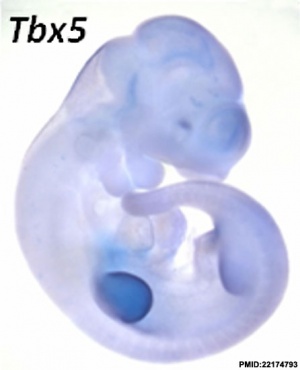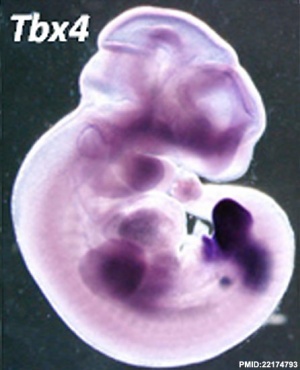Developmental Signals - Tbx
Introduction


- Draft Page.
Genes in the TBX gene family provide instructions for making proteins called T-box proteins that play critical roles during embryonic development. These proteins are especially important for normal development of the arms, hands, and heart. T-box proteins regulate the activity of other genes by attaching (binding) to specific regions of DNA. On the basis of this action, T-box proteins are called transcription factors. Genes in the T-box family are grouped together because the proteins produced from these genes share a similar segment called a T box. The T box is the part of the protein that binds to DNA. T-box proteins often interact with one another or with other transcription factors that regulate gene activity.
Researchers have identified at least 17 genes in the T-box gene family. Mutations in these genes lead to disorders that involve the abnormal development of tissues in which a particular T-box gene is active (expressed). Many genetic disorders caused by T-box gene mutations are characterized by heart problems and/or skeletal abnormalities of the hands and arms.
(text from Genetics Home Reference http://ghr.nlm.nih.gov/geneFamily/tbx)
| Factor Links: AMH | hCG | BMP | sonic hedgehog | bHLH | HOX | FGF | FOX | Hippo | LIM | Nanog | NGF | Nodal | Notch | PAX | retinoic acid | SIX | Slit2/Robo1 | SOX | TBX | TGF-beta | VEGF | WNT | Category:Molecular |
Some Recent Findings
|
References
- ↑ 1.0 1.1 <pubmed>22174793</pubmed>| PMC3235105 | PLoS One.
- ↑ <pubmed>22371266</pubmed>
Search Bookshelf Tbx
Reviews
<pubmed>17506689</pubmed> <pubmed>10197584</pubmed>
Search Pubmed
Search Pubmed Now: Tbx
Search OMIM Tbx
External Links
External Links Notice - The dynamic nature of the internet may mean that some of these listed links may no longer function. If the link no longer works search the web with the link text or name. Links to any external commercial sites are provided for information purposes only and should never be considered an endorsement. UNSW Embryology is provided as an educational resource with no clinical information or commercial affiliation.
- OMIM - http://omim.org/entry/602054
Glossary Links
- Glossary: A | B | C | D | E | F | G | H | I | J | K | L | M | N | O | P | Q | R | S | T | U | V | W | X | Y | Z | Numbers | Symbols | Term Link
Cite this page: Hill, M.A. (2024, April 19) Embryology Developmental Signals - Tbx. Retrieved from https://embryology.med.unsw.edu.au/embryology/index.php/Developmental_Signals_-_Tbx
- © Dr Mark Hill 2024, UNSW Embryology ISBN: 978 0 7334 2609 4 - UNSW CRICOS Provider Code No. 00098G